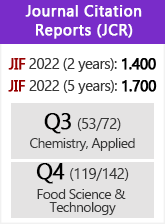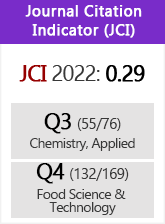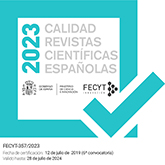Characterization of seed oils from different varieties of watermelon [Citrullus lanatus (Thunb.)] from Pakistan
DOI:
https://doi.org/10.3989/gya.022212Keywords:
Fatty acids, HPLC, Oil seeds, Oxidation state, Physicochemical attributes, Tocopherols, WatermelonAbstract
This paper reports the physicochemical characteristics of the seed oils from different varieties of watermelon (Citrullus lanatus) cultivated in Pakistan, namely Sugar Baby, Q-F-12, D-W-H-21 and Red Circle-1885. The oil and crude protein contents from watermelon seeds, within the range of 28.25 to 35.65% and 20.50 to 35.00%, respectively, varied significantly (p < 0.05) among the varieties tested. The levels of moisture, ash, and crude fiber in the seeds tested were found to be 2.16-3.24%, 1.95-3.42% and 4.29-6.60%, respectively. The physicohemical characteristics of the extracted oils were: free fatty acid contents (1.17-2.10% as oleic acid), iodine value (97.10-116.32 g of I2 100g-1 of oil), saponification index (190.20-205.57 mg KOH g-1 of oil), unsaponifiable matter (0.54-0.82%) and color (1.12-4.30 R + 12.20-33.40 Y). The oils revealed a reasonable oxidative parameter range as depicted by the determinations of specific extinction at 232 and 270 nm (2.90-4.40 and 2.05- 3.09, respectively), p-anisidine value (5.60-7.70) and peroxide value (2.90-5.06 meqO2 kg-1 of oil). Linoleic acid was the major fatty acid found in all the seed oils with contributions of 45.30-51.80% of the total fatty acids (FA). Other fatty acids detected were known to be oleic acid (20.2- 23.5%), palmitic acid (15.1-16.9%) and stearic acid (11.5- 14.4%). The contents of α- and δ-tocopherol in the oils accounted for 120.6-195.6 and 9.1-58.3 mg kg-1, respectively. The physicochemical attributes of the watermelon seed oils showed a wider variation among the varieties tested. The results of the present study indicate that the seeds of the tested watermelon varieties from Pakistan are a potential source of high-linoleic oil and thus can be explored for commercial use and value addition.
Downloads
References
Achu BM, Fokou E, Tchiegang C, Fosto M, Tchouanguep FM. 2005. Nutritive value of some Cucurbitaceae oilseeds from different regions in Cameroon. Afr. J. Biotechnol. 4, 1329-1334.
Adhikari P, Hwang KT, Shin MK, Lee BK, Kim SK, Kim SY, Lee KT, Kim SZ. 2008. Tocols in craneberry seed oils. Food Chem. 111, 687-690. http://dx.doi.org/10.1016/j.foodchem.2008.04.038
Amercian Oil Chemist's Socity (AOCS), 1997. Official and Recommended Practices of the AOCS, 7th edition, AOCS Press, Champaign.
Anhwange BA, Ajibola VO, Oniye SJ. 2004. Chemical studies of the seeds of Moringa oleifera (Lam) and Detarium microcarpum (Guill and Sperr). J. Biol. Sci. 4(6), 711-715. http://dx.doi.org/10.3923/jbs.2004.711.715
Anwar F, Latif S, Ashraf M. 2006. Analytical characterization of hemp (Cannabis sativa) seed oil from different agro-ecological zones of Pakistan. J. Am. Oil Chem. Soc. 83, 323-329. http://dx.doi.org/10.1007/s11746-006-1207-x
Anwar F, Naseer R, Bhanger MI, Ashraf S, Talpur FN, Aladedunye FA. 2008. Physiochemical characterization of citrus seeds and seed oil from Pakistan. J. Am. Oil Chem. Soc. 85, 321-330. http://dx.doi.org/10.1007/s11746-008-1204-3
Anwer T, Banger MI, Anwar F, Khan M, Shahid R, Iqbal S. 2006. A comparative characterization of different non-conventional oilseeds found in Pakistan. J. Chem. Soc. Pak. 28, 144-148.
Ardabili GA, Farhoosh R, Khodaparast HHM. 2011. Chemical composition and physicochemical properties of Pumpkin Seeds (Cucurbita pepo Subsp. Pepo Var. Styriaka) Grown in Iran. J. Agr. Sci. Tech. 13, 1053-1063.Artwatermelon. 2007. http://www.foodreference.com. (Accessed on Web12.09.2007).
Association of Official Analytical Chemists (AOAC), 1990. Determination of total protein contents, standard method 976.06
Baboli ZM, Kordi AAS. 2010. Characteristics and Composition of Watermelon Seed Oil and Solvent Extraction Parameters Effects. J. Am. Oil Chem. Soc. 87, 667-671. http://dx.doi.org/10.1007/s11746-010-1546-5
Bockisch M.1993. Handbuch der Lebensmitteltechnologie. Ulmer, Stuttgart: Nahrungsfette und Oele.
Celik F, and Ercisli S. 2009. Lipid and fatty acid composition of wild and cultivated red raspberry fruits (Rubus idaeus L.). J. Med. Plants Res. 3, 583-585.
El-Adawy TA, Taha KM. 2001. Characteristics and composition of Watermelon, Pumpkin, and Paprika seed oils and flours. J. Agric. Food Chem. 49, 1253-1259. http://dx.doi.org/10.1021/jf001117+ PMid:11312845
Frankel, EN. 2005. Lipid oxidation. The Oily Press, Bridgwater, England.
Gordon MH, Magos P. 1983. The effect of sterols on the oxidation of edible oils. Food Chem. 10, 141. http://dx.doi.org/10.1016/0308-8146(83)90030-4International Organization for Standardization (ISO) 1977. Oilseed residues determination for total ash ISO, Geneva Standard No. 749.
International Organization for Standardization (ISO) 1981. Animal Feeding Stuffs- Determination of Nitrogen and Calculation of Crude Protein content, ISO Geneva, Standard No.5983.
International Union of Pure and Applied Chemistry (IUPAC), 1987. Standard Methods for the Analysis of Oils, Fats and Derivatives, 7th rev. enlarged edn., edited by C. Paquot and A. Hautfenne, Blackwell Scientific, London.
Mabaleha MB, Mitei YC, Yeboah SO. 2007. A comparative study of the properties of selected melon seed oils as potential candidates for development into commercial edible vegetable oils. J. Am. Oil Chem. Soc. 84, 31-36. http://dx.doi.org/10.1007/s11746-006-1003-7
Malecka M. 1994. The effect of squalene on the thermostability of rapeseed oil. Nahrung, 38,135. http://dx.doi.org/10.1002/food.19940380205
Manzoor M, Anwar F, Iqbal T, Bhanger MI. 2007. Physicochemical characterization of Moringa concanensis seed and seed oil. J. Am. Oil Chem. Soc. 84, 413-419. http://dx.doi.org/10.1007/s11746-007-1055-3
Matthaus B, and Ozcan MM. 2009. Fatty acids and tocopherol contents of some Prunus spp. Kernel oil. J. Food Lipids. 16, 187-199. http://dx.doi.org/10.1111/j.1745-4522.2009.01140.x
Nehdi IA. 2011. Characteristics and composition of Washingtonia filifera (Linden ex André) H. Wendl. seed and seed oil. Food Chem. 126, 197-202. http://dx.doi.org/10.1016/j.foodchem.2010.10.099
Nicolosi RJ, Woolfrey B, Wilson TA, Scollin P. Handelman G, Fisher R. 2004. Decreased aortic early atherosclerosis and associated risk factors in hypercholesterolemic hamsters fed a high- or midoleic acid oil compared to a high-linoleic acid oil. J. Nut. Biochem. 15, 540-547. http://dx.doi.org/10.1016/j.jnutbio.2004.04.001 PMid:15350986
Oyedeji FO, Oderinde RA. 2006. Characterization of isopropanol extracted vegetable oil. J. App. Sci. 6, 2510-2513. http://dx.doi.org/10.3923/jas.2006.2510.2513Pakistan Oilseeds and Products Annual (POPA) Report. 2011.Written by Shafiq-Ur-Rehman approved by Joseph MC. Report Number: PK11003.
Parry J, Su L, Luther M, Zhou K, Yurawecz MP, Whittaker P, and Yu L. 2005. Fatty acid composition and antioxidant properties of cold-pressed marionberry, boysenberry, red raspberry, and blueberry seed oils. J. Agric. Food Chem. 53, 566-573. http://dx.doi.org/10.1021/jf048615t PMid:15686403
Pritchard JLR (1991). Analysis and properties of oilseeds. In: Rossell JB, Pritchard JLR (eds) Analysis of oilseeds, fats and fatty foods. Elsevier Applied Sciences, New York, pp 39-102.
Ramadan MF, Sharanabasappa G, Parmjyothi S, Seshagiri M, and Moersel JT. 2006. Profile and levels of fatty acids and bioactive constituents in mahua butter from fruit-seeds of buttercup tree [Madhuca longifolia (Koenig)]. Eur. Food Res. Technol. 222, 710-718. http://dx.doi.org/10.1007/s00217-005-0155-2
Rossell, JB.1991. Vegetable oil and fats. In Analysis of Oilseeds, Fats and Fatty Foods; Rossell, J. B., and Pritchard, J. L. R. Eds; Elsevier Applied Science: New York., pp 261-328.
Sies H, and Murphy ME. 1991. Role of tocopherols in the protection of biological systems against oxidative damage. J. Photochem. Photobiol. B: Biol. 8, 211-224. http://dx.doi.org/10.1016/1011-1344(91)80061-L
Steel RGD, Torrie JH, Dickey D. 1997. Principles and procedures of statistics. A biometrical approach, 3rd edition. McGraw Hills, New York, USA.
Stvenson DG, Eller FJ, Wang L, Jane JL, Wang T, Inglett GE. 2007. Oil and tocopherol content of composition of pumpkin seeds oil in 12cultivars. J. Agri. Food Chem. 55, 4005-4013. http://dx.doi.org/10.1021/jf0706979 PMid:17439238
Taiwo AA, Agbotoba MO, Oyedepo JA, Shobo OA, Oluwadare I, Olawunmi MO. 2008. Effects of drying methods on properties of water melon (Citrullus lanatus) seed oil. Afr. J. Food Agr. Nutr. Dev. 8, 1684-5374.
Tilak RM, Tukaram A, Brij ML, Valangaman SS. 2006. A study of seeds of musk melon (Cucumis melo L.), A lesser known source of edible oil. J. Sci. Food Agri. 10, 973-978.
Timmermann F. 1990. Tocopherole – Antioxidative wirkung bei fetten und ölen. Fat Sci. Technol. 92, 201-206.
Wrolstad, R.E. 2003. Analysis of Tocopherols and Tocotrienols. In: Current Protocols in Food Analytical Chemistry (CPFA), (Eds.): R. E. Wrolstad, John Wiley & Sons.
Ziyada AK, Elhussien SA. 2008. Physical and chemical characteristics of Citrullus lanatus Var. Colocynthoide seed oil. J. Phy. Sci. 19, 69-75.
Downloads
Published
How to Cite
Issue
Section
License
Copyright (c) 2012 Consejo Superior de Investigaciones Científicas (CSIC)

This work is licensed under a Creative Commons Attribution 4.0 International License.
© CSIC. Manuscripts published in both the printed and online versions of this Journal are the property of Consejo Superior de Investigaciones Científicas, and quoting this source is a requirement for any partial or full reproduction.All contents of this electronic edition, except where otherwise noted, are distributed under a “Creative Commons Attribution 4.0 International” (CC BY 4.0) License. You may read here the basic information and the legal text of the license. The indication of the CC BY 4.0 License must be expressly stated in this way when necessary.
Self-archiving in repositories, personal webpages or similar, of any version other than the published by the Editor, is not allowed.
















